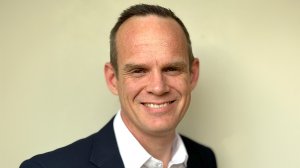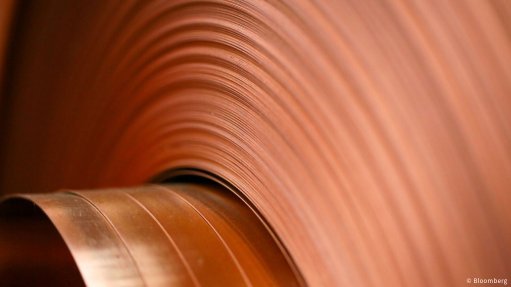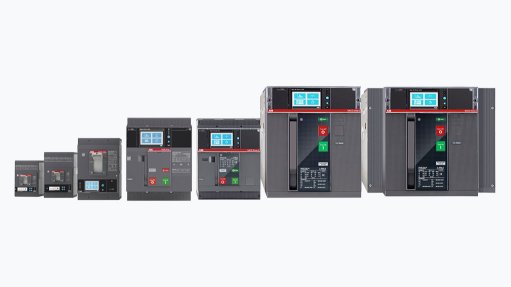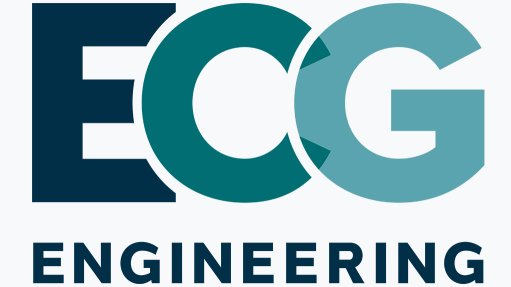High hopes for potentially game-changing technology at platinum group metal mines

African Rainbow Minerals Executive Growth Jacques van der Bijl interviewed by Mining Weekly's Martin Creamer. Video: Darlene Creamer.
JOHANNESBURG (miningweekly.com) – Development of an innovative new mining method for narrow tabular steep dipping orebodies has reached an advanced stage after four years of effort.
The reef boring machine that has already been put through its preliminary paces is viewed as having the potential to boost platinum group metals (PGM) grades through more selective mining, which then lowers unit costs, enhances safety, streamlines downstream materials – and looks like also conceivably being able to slash the size, risk and environmental impact of tailings storage facilities.
Specialists in rock cutting technology, Herrenknecht and Master Drilling, were approached to independently develop rock cutting solutions for the production mining of upper group two (UG2) reef using a mechanised mining method with the potential for autonomous mining.
Now, rock around the clock, 24/7 mining, along with eventual potential surface-controlled automation looks like possibly being on the way in the not too distant future at two of South Africa's narrow tabular orebody PGM mines on the eastern limb of the Bushveld Complex.
By targeting the high-grade upper group two (UG2) reef and minimising dilution, the mined stoping grade can be made to rocket by up to 60%.
The reef boring machines will be equipped with position sensing and steering capabilities to follow the UG2 reef horizon.
Interestingly, the new technology also comes with distinct downstream handling advantages and reduced tailings management costs, risk and, most importantly, environmental protection.
“I think this technology has the potential to be a game changer for the right orebodies,” African Rainbow Minerals (ARM) executive growth Jacques van der Bijl commented to Mining Weekly in a Zoom interview. (Also watch attached Creamer Media video.)
A reef cutting system has been custom designed to suit the UG2 reef layout of ARM's Bokoni PGM asset. In addition to the cutting head, the reef cutting system comprises several units in the on-reef drive that are essential for supplying hydraulic power and drill rods to the cutting head, as well as for removing cutting material using vacuum suction. Reef boring using vacuum suction to transport rock cuttings allows for up dip drilling. Initial results from concrete cutting trials are in-line with performance targets.
The rectangular cutting section obtained from Master Drilling’s proposed cutter head design, which uplifts grades and production rates, was custom designed to suit the UG2 reef layout of not only Bokoni but also the Modikwa PGM mine. It makes use of mechanised rock excavation, remote control and autonomous methods.
Mining Weekly: What are the objectives that ARM set for this new reef boring development?
Van der Bijl: It's been an interesting journey over the past four years. Our main goal was to find a mechanised mining solution to extract UG2 reef more selectively and efficiently, particularly in our narrow tabular orebodies at our Modikwa and Bokoni PGM mines, where nature has given us a gift with the PGM ounces concentrated in a very narrow, 60 cm reef width. However, due to limitations in technology and mining methods, we typically only end up mining at twice that width, about 120 cm, which leads up to 100% waste dilution. The surrounding pyroxenite waste does contain some PGM ounces, but not nearly as many as the UG2 reef. We explored various mining methods and ultimately chose reef boring as the best solution. This method allows us to mine high-grade reef selectively whilst minimising waste dilution, and it also offers the potential for mechanisation and eventual automation. However, one of the main challenges of reef boring, which has been extensively tried in the past, has been to achieve sufficient production volumes to make a meaningful and significant impact on the overall PGM production. For example, if a machine can only do 1 000 t to 2000 t of high-grade reef a month, the PGM content recovered is too low to contribute meaningfully to the bottom line or the mine’s production levels. To overcome this, we have set ourselves a target to achieve the same productivity, safety and cost performance as a mechanised, low-profile bord-and-pillar operation in a narrow tabular body, such as Two Rivers mine. We based our targets on the performance of a typical mechanised, stoping crew at a bord-and-pillar operation where 15 000 t a month would be typically achieved, and in the case of Two Rivers, a grade of about 3.3 g/t, 6E, which provides the equivalent of about 50 kg of PGMs a month, or about 1 600 oz. With these objectives that we set ourselves, we would not only be mining selectively and eliminating waste, but also mining at a scale that positively impacts the overall production levels.
How did you approach the development of this technology?
As a PGM mining company, we know our design objectives and mining limitations, but we're not experts in the mechanical aspects of developing reef boring technology. To bridge this gap, we partnered with Herrenknecht, a German company known for their excellence in designing and manufacturing tunnel boring machines worldwide, and also Master Drilling, a South African company that specialises in reef boring solutions. Most previous attempts of reef boring have been using a single circular profile. But to limit dilution, the diameter of a single circular profile can't be much greater than the width of the reef horizon. In our case, at Bokoni and Modikwa, the single circular 60 cm diameter reef boring would result in quite a small cross sectional area, which then struggles to meet meaningful production levels with current technology in terms of how fast you can advance from a drilling perspective. To meet our production targets with a single cutter head design, the drilling rate would have to be up to three times higher than what's currently possible with current drilling technology. To overcome this challenge, we started to evaluate various different drilling concepts against our goals. Herrenknecht then proposed quite an innovative solution to address the cross sectional challenge by using three overlapping cut heads in one frame, while Master Drilling focused on attaining a rectangular cut profile instead of a circular cut profile, which maximises reef extraction and minimises the waste dilution. Both approaches aimed at increasing the production and reducing waste. In developing these two concepts, a phased development approach was adopted, involving testing each aspect of the technology step by step. For instance, an hydraulic test frame was developed. This involved a single disc cutter head, which we took underground at one of our PGM mining operations, and mounted it against a mining pillar to thoroughly test the torque, thrust and penetration range for a single disc cutter on both UG2 and pyroxenite waste. The data that we then gathered from those tests have been valuable in designing the final cutting head design of the reef boring solution. By partnering with these two specialist companies and also taking a methodical approach to development, we were able to develop a technology that meets our specific needs while also leveraging the expertise of our partners.
What are the specific concepts proposed by Herrenknecht and Master Drilling?
The Herrenknecht setup of tackling the challenge of limited cross sectional area in a circular boring solution, by proposing three overlapping cut heads in one frame, allows for the drawing up to three times the amount of rock per metre. This company’s extensive experience in boxhole boring as well as in pipejacking, helped to reduce the development risk of this approach. An additional advantage of this concept is the very consistent rock fragmentation, which then simplifies and reduces the downstream materials handling infrastructure requirements. On the other hand, Master Drilling’s achieving of a rectangular cut profile maximises UG2 reef extraction while minimising the mining of the pyroxenite waste. The rectangular cut profile results in a 3 m wide by 0.6 m high excavation. The design keeps the cutting head inside of the reef horizon, and therefore also minimises waste dilution, which helps us to achieve the highest grade possible. An added advantage of the rectangular cutting is that it also allows mining to only take place in the softer UG2. In the case of Bokoni, UG2 has a typical hardness of about 60 MPa to 70 MPa, while pyroxenite’s hardness is a considerably higher 130 MPa. Staying in the UG2 can in theory provide faster advance rates, because the softer rock can be excavated quicker. In addition, there is an element of self-steering, because the cutter head tends to want to stay within the harder hangingwall and footwall formation, minimising dilution from the cut. Both concepts are quite innovative, and their aim is the same, which is to increase reproduction whilst minimising waste dilution.
What is the potential production impact of this technology?
It's well suited for the mechanised mining of consistent, narrow, tabular orebodies, where the orebody dip is steeper than 12 degrees, which make mechanised, low-profile bord-and-pillar operations unviable. Our production goal is to match the ounce profile of a mechanised stoping crew at Two Rivers of 15 000 t month at 3.3 g/t, which gives you circa 1 600 oz contained per month per crew. With the reef boring machine, we aim to achieve the same amount of ounces, but from fewer tons, due to the high grades achieved with the selective mining. However, for this to work, the orebody needs to be consistent without split reef or significant undulations. For instance, it won't be suitable at our Two Rivers platinum mine because the high number of split reefs, dykes, and faults. But it seems to be well suited for Bokoni mine, where the orebody is uniform and consistent with minimal undulations and faults. Provided the technology is applied in the right conditions, it has the potential to significantly enhance grade and production efficiencies, and then ultimately positively impact unit costs.
How does reef boring improve safety?
One of the key benefits is that employees are not required to enter into the stopes as the mining is done completely remotely. This offers significant safety advantages by eliminating high risk events such as fall of ground accidents as well as scraper winch incidents, which are the leading causes of safety incidents in our underground conventional mines. Additionally, the activities involved in reef boring are completely mechanised, which means the operators don't have to be in close proximity to the operations, which then further reduces the chances of any safety incidents.
How does the technology affect PGM grades and mining costs?
If you compare it with the current conventional mining methods employed at Modikwa, as well as previously at Bokoni, the reef boring method has the potential to deliver PGM grades of up to 60% better than with a conventional mine. This is achieved by maximising the UG2 reef extraction whilst minimising the inclusion of the low PGM content pyroxenite waste from the hangingwall and footwall. But beyond just improving grades, this technology is also well suited for mechanisation and then ultimately automation, which can lead to further improvements in productivity and lower mining cost per ton. When you combine the higher PGM grades with the lower cost per ton, then this promises a significant improvement in cost per PGM ounce. The key challenge, however, is obtaining necessary production volumes per month, and that's where previous attempts have fallen short. We aim to verify achieving these production targets over the next two years as we deploy this technology at Bokoni.
What downstream handling advantages does reef boring offer?
The big benefit is the consistent rock chip size that you get produced by the reef boring, which offers many downstream handling advantages. Firstly, it simplifies conveyor and rock transfer chutes, eliminating the need for, for instance, for underground rock breakers and crushers. Then, in addition, if you look at Herrenknecht’s reef boring solution with the small rock fragmentation that you get with the tungsten carbide inset roller cutters that they use, this allows the option to pump the rock chips directly from underground to surface and also potentially directly to the concentrator plant, which could significantly reduce capital costs by eliminating the need for underground and surface conveyor systems, as well as for truck hauling.
How does the technology influence tailings management?
Reef boring has got potential to significantly positively impact tailings management by reducing costs, risk and, most importantly, the environmental impact. The high grade of the reef mining allows us to justify cost of placing backfill underground into previously mined stopes. This increases the extraction percentage of the orebody to greater than 90% which extends the life of mine, improves the stopping to development ratio, which then enhances the run of mine grades, and also reduces the amount of mining development required. Additionally, the ability to place tailings underground, combined with more selective mining and minimising waste dilution, reduces the footprint in the size of the tailings storage facility required on surface, and the operating capital costs associated with running the tailing storage facility.
What is the current status of the next steps for African Rainbow Minerals in this development?
We have completed numerous full-scale cutting tests for both the concepts on both high strength concrete as well as granite blocks, which then closely replicates the hardness and the qualities of the UG2 reef and pyroxenite. The results from these tests have been very encouraging. We've been able to double the performance compared to our design objectives that we set ourselves. We currently in the process of constructing the remaining system modules to complete the full-scale reef boring system, and the aim is to commence with proof of concept test at the Bokoni mine. Depending on the outcome of these tests, we will then decide on a full implementation of reef boring solutions at Bokoni. We've been developing this technology for four years now, and we understand that it takes a very long time to fully develop these types of technologies, and I think there would be undoubtedly a lot more unforeseen hurdles to overcome, but we believe that our systematic, risk adjusted development approach that we've taken in developing this technology, combined with our determination to make this technology work, will eventually ensure success in the long run.
Article Enquiry
Email Article
Save Article
Feedback
To advertise email advertising@creamermedia.co.za or click here
Press Office
Announcements
What's On
Subscribe to improve your user experience...
Option 1 (equivalent of R125 a month):
Receive a weekly copy of Creamer Media's Engineering News & Mining Weekly magazine
(print copy for those in South Africa and e-magazine for those outside of South Africa)
Receive daily email newsletters
Access to full search results
Access archive of magazine back copies
Access to Projects in Progress
Access to ONE Research Report of your choice in PDF format
Option 2 (equivalent of R375 a month):
All benefits from Option 1
PLUS
Access to Creamer Media's Research Channel Africa for ALL Research Reports, in PDF format, on various industrial and mining sectors
including Electricity; Water; Energy Transition; Hydrogen; Roads, Rail and Ports; Coal; Gold; Platinum; Battery Metals; etc.
Already a subscriber?
Forgotten your password?
Receive weekly copy of Creamer Media's Engineering News & Mining Weekly magazine (print copy for those in South Africa and e-magazine for those outside of South Africa)
➕
Recieve daily email newsletters
➕
Access to full search results
➕
Access archive of magazine back copies
➕
Access to Projects in Progress
➕
Access to ONE Research Report of your choice in PDF format
RESEARCH CHANNEL AFRICA
R4500 (equivalent of R375 a month)
SUBSCRIBEAll benefits from Option 1
➕
Access to Creamer Media's Research Channel Africa for ALL Research Reports on various industrial and mining sectors, in PDF format, including on:
Electricity
➕
Water
➕
Energy Transition
➕
Hydrogen
➕
Roads, Rail and Ports
➕
Coal
➕
Gold
➕
Platinum
➕
Battery Metals
➕
etc.
Receive all benefits from Option 1 or Option 2 delivered to numerous people at your company
➕
Multiple User names and Passwords for simultaneous log-ins
➕
Intranet integration access to all in your organisation

















